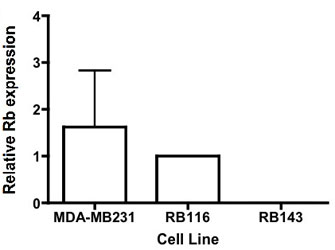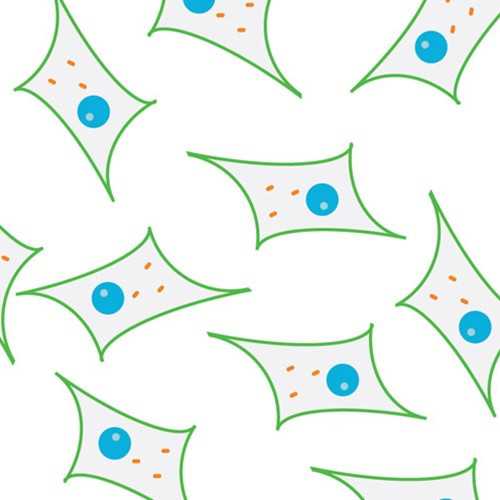Retinoblastoma Cell Line (RB116)
Retinoblastoma Cell Line (RB116) expresses RB1 accompanied by atypical perinuclear localization. RB116 cells also express primitive stem cell and retinal progenitor cell markers.
Highlights:
- Express RB1 accompanied by atypical perinuclear localization
- Subpopulations express stem cell markers ABCG2, Oct3/4, ALDH1A1, and Nanog
- Subpopulations exhibit immunoreactivity to retinal progenitor markers PAX6 and CHX10
Retinoblastoma (RB), an intraocular tumor of childhood, is commonly associated with mutations in the RB1 gene. Loss of RB1 function is associated with a variety of human cancers, while inactivation of the RB1 tumor suppressor gene has been reported in several human malignancies in addition to RB, such as cancers of the breast, prostate, and lung. Furthermore, the RB1 gene family is intimately involved in the control of cellular proliferation, survival, and differentiation pathways in many mammalian cells.
Also available: Retinoblastoma, RB1 Negative Cell Line (RB143)
From the laboratory of Bruce R. Ksander, PhD, Schepens Eye Research Institute.
 Part of The Investigator's Annexe program.
Part of The Investigator's Annexe program.
Retinoblastoma Cell Line (RB116) expresses RB1 accompanied by atypical perinuclear localization. RB116 cells also express primitive stem cell and retinal progenitor cell markers.
Highlights:
- Express RB1 accompanied by atypical perinuclear localization
- Subpopulations express stem cell markers ABCG2, Oct3/4, ALDH1A1, and Nanog
- Subpopulations exhibit immunoreactivity to retinal progenitor markers PAX6 and CHX10
Retinoblastoma (RB), an intraocular tumor of childhood, is commonly associated with mutations in the RB1 gene. Loss of RB1 function is associated with a variety of human cancers, while inactivation of the RB1 tumor suppressor gene has been reported in several human malignancies in addition to RB, such as cancers of the breast, prostate, and lung. Furthermore, the RB1 gene family is intimately involved in the control of cellular proliferation, survival, and differentiation pathways in many mammalian cells.
Also available: Retinoblastoma, RB1 Negative Cell Line (RB143)
From the laboratory of Bruce R. Ksander, PhD, Schepens Eye Research Institute.
 Part of The Investigator's Annexe program.
Part of The Investigator's Annexe program.
| Product Type: | Cell Line |
| Name: | RB116 |
| Cell Type: | Retinoblastoma |
| Accession ID: | CVCL_S608 |
| Morphology: | Multicellular clusters |
| Organism: | Human |
| Source: | Established from an explant of a large primary human RB tumor and provided for this study without patient identifiers |
| Biosafety Level: | BSL1 |
| Growth Conditions: | RPMI medium with 1% 4-(2-hydroxyethyl)-1-piperazineethanesulfonic acid (HEPES), 10% calf serum |
| Storage: | Liquid nitrogen |
| Shipped: | Dry ice |
RBI gene expression in RB116, RB143 and breast cancer MDA-MB231 cells

Quantitative reverse transcriptase polymerase chain reaction (qRT-PCR) analysis shows RB1 mRNA expression in RB116 cells. RB116 cells were evaluated alongside RB1-negative RB143 cells and RB1-positive MDA-MB231 breast cancer cells. RB116 cell expression was set at 1.0. The experiment was repeated three times and the error bars show standard deviation. No p values were calculated, as this was an experiment to determine presence or absence of RB1 and not meant to be comparative between cell lines. RB1 mRNA (mRNA) was detected in both RB116 and MDA-MB231 cells.
Adapted from: Bejjani A., et al. Mol Vis. 2012;18:2805-13. Epub 2012 Nov 29.
- Bejjani A, Choi MR, Cassidy L, Collins DW, O'Brien JM, Murray T, Ksander BR, Seigel GM. RB116: an RB1+ retinoblastoma cell line expressing primitive markers. Mol Vis. 2012;18:2805-13. Epub 2012 Nov 29.
- Duminuco R, Noble JW, Goody J, Sharma M, Ksander BR, Roskelley CD, Cox ME, Mills J. Integrin-Linked Kinase Regulates Senescence in an Rb-Dependent Manner in Cancer Cell Lines. Cell Cycle. 2015 Jul 15:0.
- Li Z, Li Q, Wang G, Huang Y, Mao X, Zhang Y, Wang X. Inhibition of Wnt/β-catenin by anthelmintic drug niclosamide effectively targets growth, survival, and angiogenesis of retinoblastoma. Am J Transl Res. 2017 Aug 15;9(8):3776-3786. eCollection 2017. View Article
- Ke F, Yu J, Chen W, Si X, Li X, Yang F, Liao Y, Zuo Z. The anti-malarial atovaquone selectively increases chemosensitivity in retinoblastoma via mitochondrial dysfunction-dependent oxidative damage and Akt/AMPK/mTOR inhibition. Biochem Biophys Res Commun. 2018 Jun 14. View Article
If you publish research with this product, please let us know so we can cite your paper.


